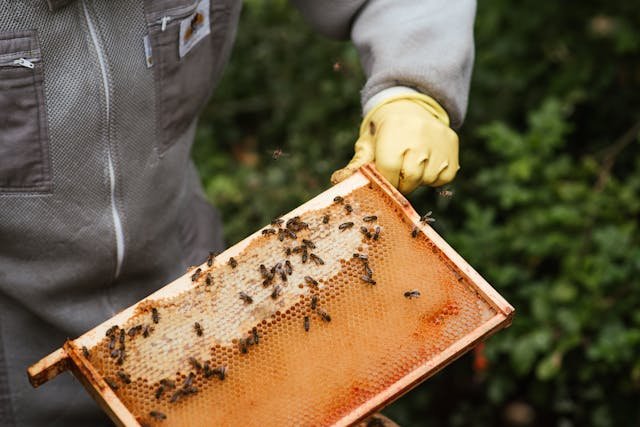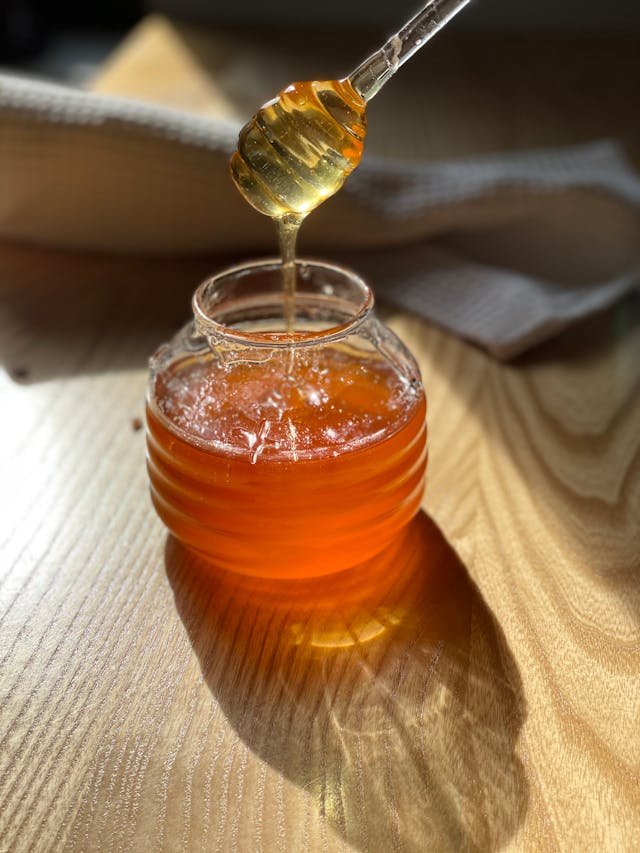In a world saturated with processed foods and artificial sweeteners, there exists a natural treasure often overlooked – raw honey. Imagine dipping into a jar of honey, not like as transperant golden syrup found on supermarket shelves, but a thick, unfiltered and healthful goodness straight from the hive. Raw honey, with its rich flavors, medicinal properties, and cultural significance, is indeed a global treasure waiting to be discovered.
In this article, we embark on a journey to explore the hidden depths of raw honey – from its origins in distant lands to its ample benefits for body and soul. Join us to discover enchanting world of raw honey, uncovering its secrets, debunking myths, and revealing how this natural wonder has captivated humanity for centuries. Prepare to be amazed, informed, and inspired by the untold story of raw honey: a global treasure ripe for exploration.
What is Raw Honey?
Raw honey is honey in its purest form. It is extracted directly from the honeycomb and is neither heated nor filtered, which allows it to retain all the beneficial nutrients and enzymes. This natural state sets raw honey apart from commercially processed honey, which often loses many of its healthful properties due to pasteurization and filtration.
10 most Benefits of Raw Honey
1. Immune-Boosting Properties:
Raw honey serves as a powerful ally in fortifying the immune system, thanks to its antimicrobial and antioxidant properties. Regular consumption of raw honey can help ward off infections and bolster the body’s defenses against illness.
2. Wound-Healing Abilities:
Renowned for its centuries-old use in wound care, raw honey possesses remarkable healing properties. Its antibacterial and anti-inflammatory qualities promote tissue regeneration and accelerate the healing process, making it an invaluable resource for treating cuts, burns, and ulcers.
3. Allergy Alleviation:
Contrary to conventional wisdom, local raw honey may offer relief from seasonal allergies. Consuming small amounts of raw honey sourced from local bees exposes the body to trace amounts of pollen,potentially desensitizing the immune system and reducing allergy symptoms.
4. Digestive Support:
Enzymes present in raw honey aid in digestion, facilitating the breakdown of carbohydrates and promoting gut health. Additionally, raw honey’s prebiotic properties nourish beneficial gut bacteria, fostering a balanced microbiome and improving overall digestive function.
5. Skin Rejuvenation:
6. Sleep Aid:
The consumption of raw honey before bedtime may promote restful sleep. Raw honey’s natural sugars help stabilize blood sugar levels throughout the night, preventing nocturnal awakenings, while its amino acid content supports the production of serotonin, a neurotransmitter that induces relaxation and promotes sleep.
7. Energy Boost:
Raw honey serves as a natural source of energy, providing a quick and sustainable fuel source for the body. Its blend of carbohydrates, vitamins, and minerals offers a gentle energy boost without the crash associated with refined sugars or caffeine.
8. Cardiovascular Health:
Studies suggest that regular consumption of raw honey may support heart health by reducing LDL cholesterol levels, lowering blood pressure, and improving overall vascular function. Its antioxidant properties also help combat inflammation and oxidative stress, factors implicated in cardiovascular disease.
9. Cognitive Enhancement:
Raw honey contains natural compounds such as antioxidants and polyphenols that have been shown to support cognitive function and protect against age-related cognitive decline. Regular consumption of raw honey may thus contribute to enhanced memory, focus, and mental clarity.
10. Athletic Performance:
Athletes have long relied on raw honey as a natural sports supplement to fuel their performance and aid in post-exercise recovery. Its unique blend of carbohydrates provides a sustained energy release, while its anti-inflammatory properties help alleviate muscle soreness and promote faster recovery.
Pros and Cons
- Nutrient-Rich: Raw honey is a veritable powerhouse of nutrients, boasting vitamins, minerals, enzymes, and antioxidants that nourish the body and fortify the immune system.
- Natural Healing Properties: Renowned for its antibacterial, antiviral, and anti-inflammatory properties, raw honey serves as a potent remedy for ailments ranging from sore throats to skin infections.
- Digestive Aid: Enzymes present in raw honey aid in digestion, promoting gut health and alleviating symptoms of indigestion and bloating.
- Antioxidant Powerhouse: Packed with flavonoids and phenolic acids, raw honey combats oxidative stress, reducing the risk of chronic diseases and promoting overall well-being.
- Soothing Sweetness: Beyond its nutritional prowess, raw honey delights the palate with its diverse array of flavors, from floral and fruity to robust and earthy, enhancing culinary creations with its natural sweetness.
- Risk of Contamination: Raw honey may harbor harmful bacteria and spores, posing a potential risk of foodborne illness, particularly for vulnerable populations such as infants and individuals with compromised immune systems.
- Potential Allergen: For those with pollen allergies, raw honey can trigger allergic reactions, manifesting as itching, hives, or even anaphylaxis in severe cases.
- Caloric Content: While raw honey offers healthful nutrients, it is dense in calories and sugars, necessitating moderation to avoid adverse effects on weight and blood sugar levels.
- Natural Variability: The unprocessed nature of raw honey results in variability in taste, texture, and appearance, with some batches crystallizing or exhibiting cloudiness over time, potentially impacting consumer preferences.
- High Cost: Due to its minimal processing and labor-intensive production methods, raw honey often commands a higher price point than its commercially processed counterparts, limiting accessibility for some consumers.
10 Most Uses of Raw Honey in Different Foods: Raw Honey – A Global Treasure
1. Sweetening Beverages:
From herbal teas to fruit-infused waters, raw honey adds a touch of sweetness and depth of flavor to a wide array of beverages, enhancing their taste and aroma.
2. Breakfast Delights:
Drizzle raw honey over pancakes, waffles, or French toast for a delectable breakfast treat, or swirl it into yogurt or oatmeal for a nutritious and satisfying start to the day.
3. Baking Marvels:
Use raw honey as a natural sweetener in baked goods such as cakes, cookies, and muffins, imparting a moist texture and subtle floral undertones to your creations.
4. Salad Dressings:
Whisk together raw honey, olive oil, vinegar, and herbs to create homemade salad dressings that add a sweet and tangy twist to fresh greens and vegetables.
5. Marinades and Glazes:
Marinate meats, poultry, or tofu in a mixture of raw honey, soy sauce, garlic, and ginger for tender and flavorful dishes, or use raw honey as a glaze for roasted vegetables or grilled seafood.
6. Dessert Delicacies:
Enhance desserts with the natural sweetness of raw honey, whether drizzling it over fresh fruit, mixing it into ice cream or yogurt, or incorporating it into decadent pastries and pies.
7. Energy-Boosting Snacks:
Create homemade energy bars or granola bites using raw honey as a binding agent, combining it with nuts, seeds, dried fruit, and oats for a nutritious and portable snack.
8. Spreads and Dips:
Blend raw honey with nut butter or cream cheese to create creamy spreads for toast, crackers, or fruit slices, or use it as a dip for pretzels, apple slices, or carrot sticks.
9. Meat Tenderizers:
Tenderize and flavor meats by brushing them with a mixture of raw honey, mustard, and herbs before grilling or roasting, creating succulent and caramelized dishes that are sure to impress.
10. Culinary Condiments:
Elevate the flavor of sauces, salsas, and chutneys by incorporating raw honey as a natural sweetener, balancing out the acidity of tomatoes or the heat of peppers with its subtle sweetness.
Frequently Asked Questions
1. What is the difference between raw honey and regular honey?
• Raw honey is unprocessed and unpasteurized, retaining all its natural nutrients, enzymes, and antioxidants. Regular honey is often heated and filtered, which can remove or destroy these beneficial components.
2. How can you tell if honey is raw?
• Raw honey often has a cloudy appearance due to the presence of pollen and other natural particles. It may also crystallize more quickly than processed honey.
3. Is raw honey safe for everyone?
• While raw honey is safe for most people, it should not be given to infants under one year old due to the risk of botulism. People with severe pollen allergies should also consult a doctor before consuming raw honey.
4. Can raw honey go bad?
• Raw honey has an indefinite shelf life if stored properly in a sealed container away from moisture. It may crystallize over time, but this does not mean it has gone bad.
5. How should raw honey be stored?
• Store raw honey in a cool, dry place in a tightly sealed container. Avoid exposing it to direct sunlight or heat, which can degrade its quality.
In conclusion, raw honey is a remarkable natural product with a wide array of health benefits and versatile uses in the kitchen. Whether you’re using it as a natural sweetener or a healing agent, raw honey offers numerous advantages, making it a valuable addition to your daily life.
From breakfast to dessert and everything in between, raw honey lends its unique flavor and nutritional benefits to a diverse range of culinary creations, making it a truly indispensable ingredient in kitchens around the world. Embrace the versatility of raw honey and unleash your creativity in the kitchen, as you discover the endless possibilities of this global treasure.



